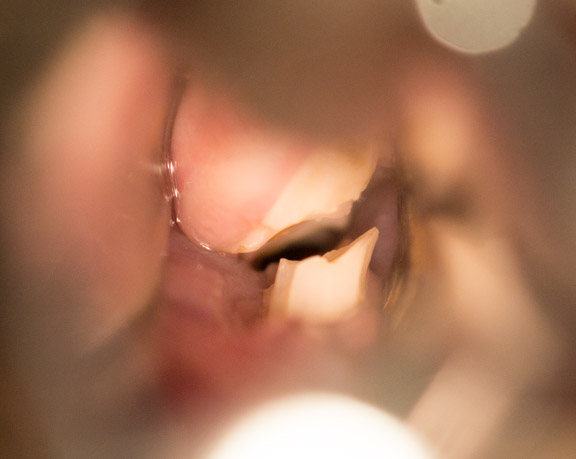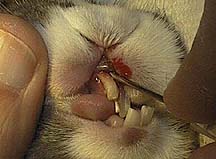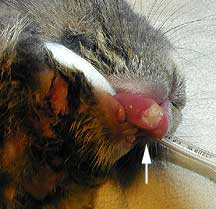Rabbit teeth grow continuously throughout their lives. Normal chewing action wears them down just to the point that they don’t overgrow. This is one of the reasons it is important to feed your rabbit a high fiber diet. A rabbit that has a malocclusion does not have this normal wearing action and can suffer overgrown teeth. This problem can be serious enough to inhibit the ability to eat. This page goes over rabbit teeth conditions.
To learn more about rabbits in general, visit the House Rabbit Society website.
Incisor Teeth
These teeth grow continuously, so unless there is something for them to to wear on they will overgrow. In most rabbits trimming the incisor teeth solves the problem temporarily. They have sensitive teeth with deep roots that can easily crack, so it’s not a good isea to do this at home.
The arrow points to the deep roots of the rabbit upper incisor teeth
They are trimmed with a special scissors that will not crack them. If needed, they are also filed to remove any sharp edges. This technique should not be tried by inexperienced people because teeth are brittle in nature, and in this case are weaker than normal due to the abnormality. They can easily fracture because of these two factors. In addition, rabbits can fracture their back if not properly restrained.
This patient has overgrown lower incisors. They are definitely inhibiting its ability to chew. They need periodic trimming every 4 weeks to prevent recurrence.
Our special scissors allow us to trim them back
These upper incisors are growing into the lower jaw
Our friend feels much better thank you, and can now get back to normal rabbit activity like non-stop eating. He needs to return in 4 weeks to have his teeth checked.
This rabbit has an upper right incisor (arrow) that has been chronically infected. We decided to remove the incisors because trimming the teeth was not solving the problem.
The arrow points to the cracked and infected tooth
As you saw from the x-ray pictures the roots of these incisors are very deep and they curve significantly. Great care must be taken during their removal so they don’t crack at the root.
In this picture we are gently breaking down the attachment of the tooth to the gums
This is the appearance immediately after surgery
Molar Teeth
These teeth tend to give rabbits more trouble than the incisors do. They can become overgrown and get painful points on them. The points are painful, dig into the gums or tongue, and can prevent eating. Molar teeth are not easy to assess. Rabbits don’t like anything in their mouths, and the folds of skin of the cheeks interfere with visualization.
Rabbits need to be anesthetized to properly assess and treat their teeth, especially their molars. You can learn much more about how we anesthetized patient at this link to our anesthesia page.
We use a gas anesthesia that is safe and gentle. We keep them wrapped in warm towels and also use a warm water blanket so they do not get chilled.
If a rabbit requires major surgery we sometimes will intubate them. The arrow points to the ET (endotracheal tube).
This bun bun under gas anesthesia is getting a thorough oral exam, starting with the incisor teeth
The oral cavity in the rabbit is small, and the molar teeth we need to examine are deep inside and covered by the fleshy folds of the inner cheeks. We need special lighting and instruments to do a thorough assessment. Dr. Wood and Terri work as an experienced team to treat these rabbits rapidly and effectively.
We use a speculum with a special light that gives us the visualization we need
The black arrow points to the molars with points on them that are irritating the tongue. This rabbit is not eating due to this problem.
The laceration in the tongue is visible within the blue circle
A special instrument called a rongeur is used to remove the points rapidly
The molars are then gently filed to smooth them off. This allows the tongue to heal and the rabbit to return to normal eating.
They are kept warm during recovery and watched carefully by our technicians until they can completely stand
This is a different rabbit that was also not eating well. The tongue was not having any problem with the points on the molar teeth, but the rabbit was still unable to eat.

After trimming and filing the rabbit can eat again
Root Problems
In some rabbits the problem is much more serious than overgrown and unsightly incisors or points on the molar teeth. These rabbits have severe problems with the roots of the molar teeth, preventing them from eating properly. These teeth sometimes need to be removed. If left untreated they can die. A large part of their problem is a diet that is too low in fiber. This causes improper wearing down of the molars, and even can lead to elongation of the roots of the incisors.
This is a picture of Mike’s lower jae. He has overgrown molar roots that we will be removing. We diagnosed Mike’s problems partially by a history of weight loss and poor appetite, along with excessive salivation.
You can see the chronic irritation the saliva has caused under his chin
A radiograph was important in the diagnosis. The arrow points to the elongation of the roots of the molar teeth. Compare it to the rabbit below with normal molar roots.
The arrow points to normal roots of the molar teeth. Can you see a difference compared to the radiograph above?
.
Mike came in weak and dehydrated due to his inability to eat. He feels much better now that he is getting rehydrated.
Putting an IV catheter in a rabbit takes special skill from our nursing staff. You can learn more about catheters if you like by following the IV catheter link.
Special instruments are needed for the extraction of the bad teeth
Now that Mike is finally anesthetized we can gain access to his molar teeth. The white arrow points to one of them deep in his oral cavity.
These are the teeth immediately after removal. The roots are on the bottom.
A closeup of one of them shows the infection around the root (on the right).
Unfortunately, Mike had more than teeth problems. He had abscesses in his eye and on his tongue caused by Pasteurella.
The arrow points to the ulcer he has on the tip of his tongue.\
Prevention
One of the most important things you can do to keep your rabbit’s teeth healthy is to feed a high fiber diet. This consists of mostly timothy hay or timothy hay pellets.
Regular exams by one of our doctors will also catch this problem before teeth get infected or your rabbit becomes ill.
Return to Rabbit Diseases Page.































